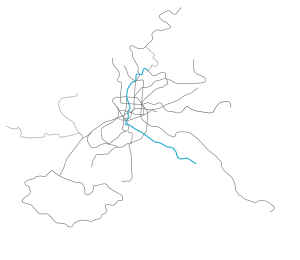Line 1 (Metro Madrid)
The line 1 (span. Linea 1 , short L-1) is a subway -line of Metro Madrid . It leads from the Pinar de Chamartín to Valdecarros , is 23.9 kilometers long and has 33 stations. The average station distance is 717 meters. The route is completely underground. The L-1 belongs to the metro's small profile network and the length of the stations is 90 meters. You can change to other metro lines at nine stations, and at three stations to the Cercanías suburban railway .
history
Construction work on the L-1 began on July 17, 1917, just under six months after the Metro company was founded. On October 17, 1919, King Alfonso XIII opened. officially the first section. This led from Sol to Cuatro Caminos . Scheduled operations began exactly two weeks later. The new means of transport proved to be a great success right from the start, and land prices along the route rose sharply. The metro company also wanted to benefit from the real estate boom and had an entire district built west of Cuatro Caminos , on the outskirts of the city at the time.
From an extension to Atocha station , the company expected an even higher number of passengers. This section opened on December 26, 1921. The Progreso intermediate station (now Tirso de Molina ) was planned so that a branch line towards Legazpi could have been built. But the plans were changed a few years later. For this reason, the L-1 and the L-3 cross twice within a few hundred meters; first at the Sol station , then again shortly after Tirso de Molina . On May 8, 1923, another extension to the south to Puente de Vallecas followed . The northern extension to Tetuán followed on March 6, 1929.
On February 4, 1961, the L-1 was extended from Tetuán to today's northern endpoint Plaza de Castilla . The plans at that time provided for extending the L-1 further to Chamartín station and to Fuencarral ; however, this connection is now covered by the L-10 . On July 2, 1962, the line was extended to Portazgo at the other end . The stations on these new sections were built with 90 meter long platforms. By 1966, the older stations, which were 60 meters long, were adapted accordingly. So longer trains could be used. However, the Chamberí station was not rebuilt because this measure meant that it was only 230 and 310 m away from the Iglesia and Bilbao stations . This station was closed on May 21, 1966.
At the end of the 1980s, Atocha train station was moved a few hundred meters south. Since the existing metro station was now too far from the platforms, a new station called Atocha Renfe was built a little further to the south-east and started operating on July 25, 1988. The line was then extended in two stages beyond Portazgo to the southeast, first in April 1994 to Miguel Hernández and finally on March 4, 1999 to Congosto . At the intermediate station Sierra de Guadalupe , a pedestrian connection was created to the Cercanías station Vallecas, which in turn had been moved 500 meters to the east.
In 2007, three extensions were put into operation in quick succession: first on March 30th from Plaza Castilla to Chamartín train station, then on April 11th from Chamartín to Pinar de Chamartín , and finally on May 17th from Congosto to Valdecarros .
Web links
- Plano del Metro de Madrid on planosdemetro.com with basic information about the line
